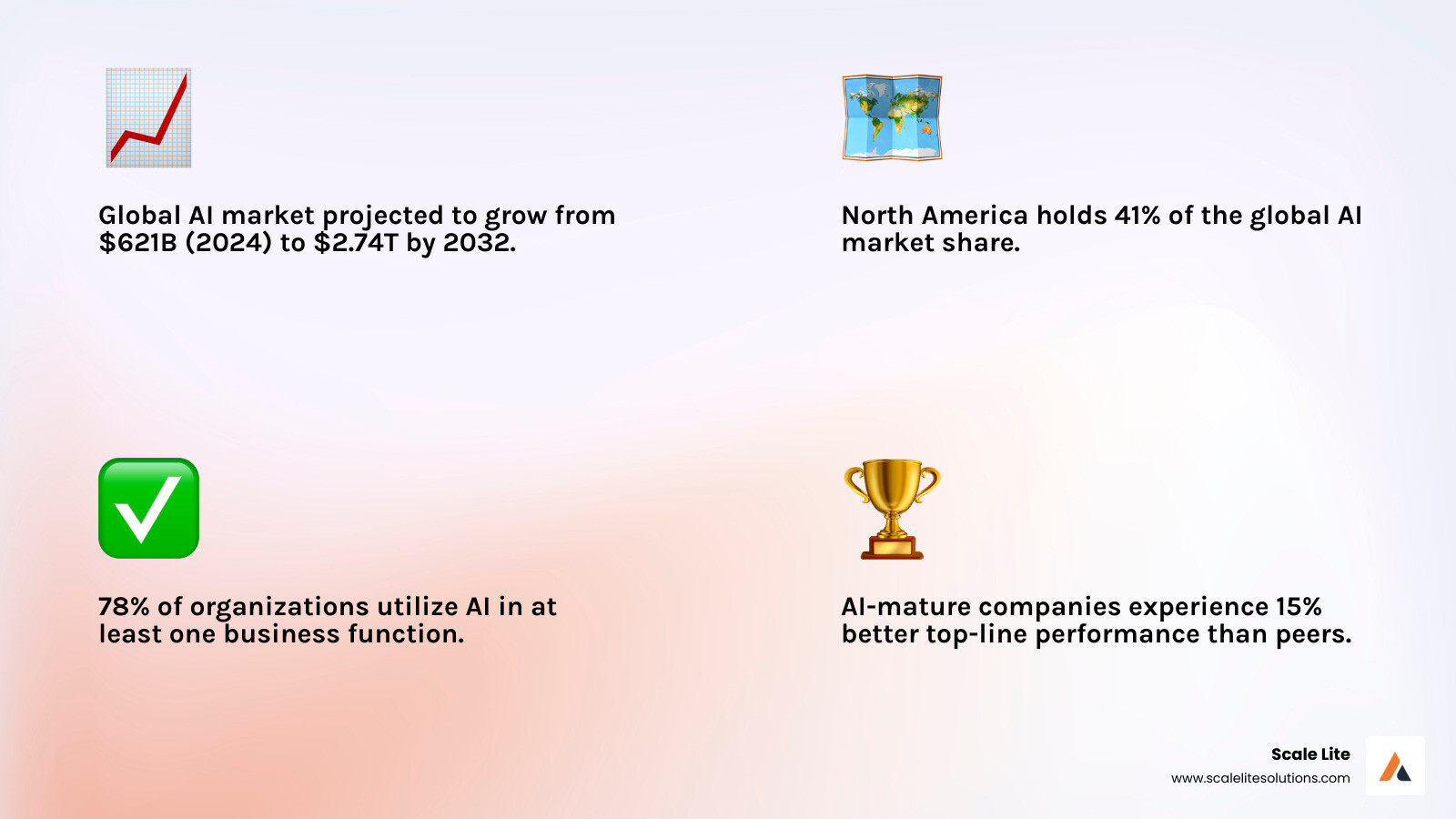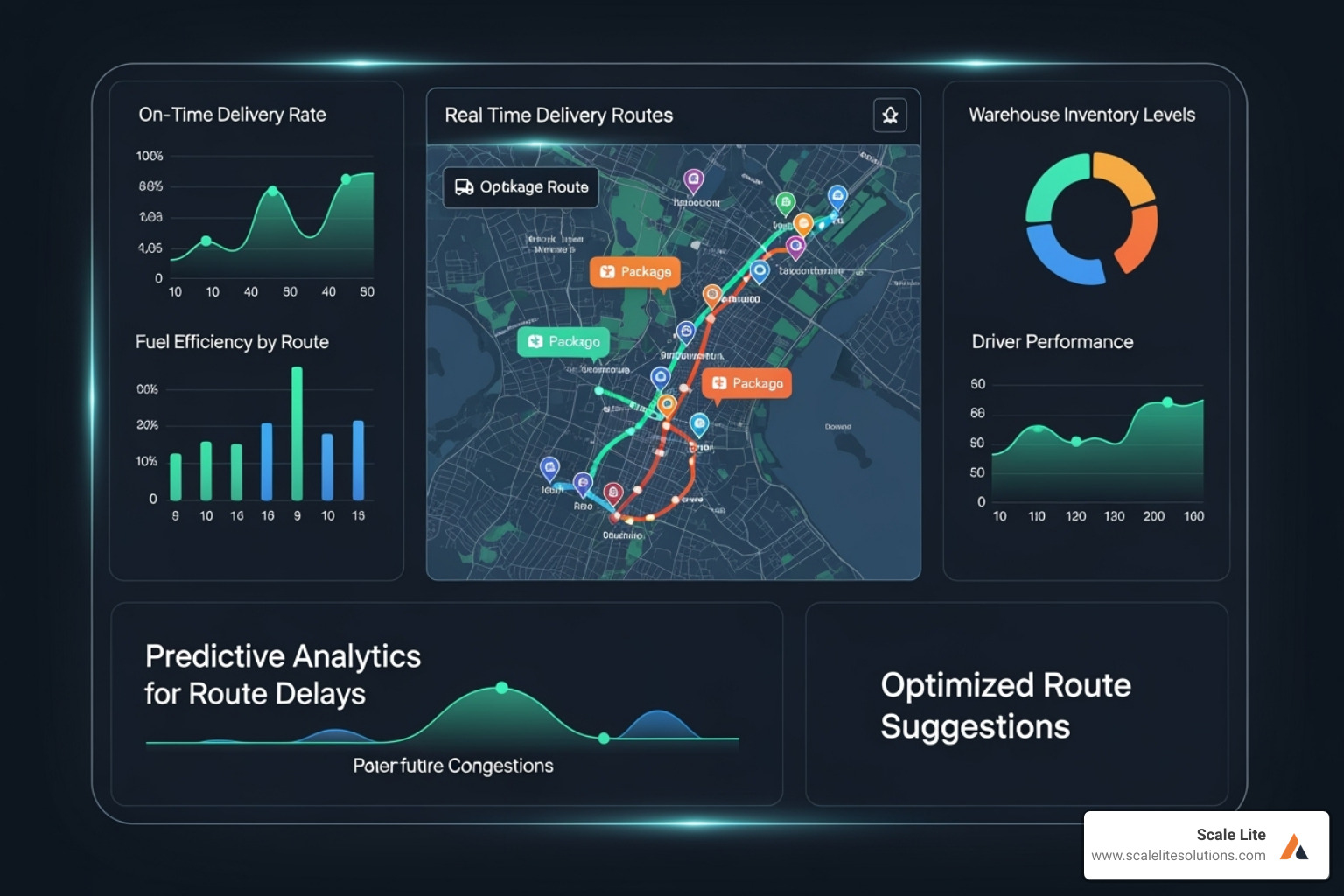
Tech Your Business to the Next Level with AI-Driven Growth

Why AI is Essential for Modern Business Growth
AI-driven business growth is no longer just a tech trend—it's the foundation for how successful companies operate and compete. Here's what you need to know:
- Revenue Impact: Companies with high AI maturity grow 4.7x faster than their competitors
- Market Value: AI adoption could deliver up to $4.4 trillion in global economic value annually
- Growth Timeline: AI-mature companies see 15% better performance than peers, expected to double by 2026
- Investment Priority: 67% of companies will focus on AI for growth and expansion by 2029
The numbers tell a clear story. Since 2022, businesses that effectively use AI have been growing 3 percentage points more year-over-year than those that don't. It's not about replacing your workforce, but empowering them to work smarter, serve customers better, and scale sustainably.
For blue-collar and service businesses, AI might seem out of reach, but that's changing fast. AI tools now help contractors respond to leads within 5 minutes (making them 400% more likely to win jobs), automate scheduling to reduce no-shows, and analyze customer data to predict which services will be most profitable.
The reality is simple: businesses that ignore AI risk falling behind. The good news is that you don't need a massive budget or a computer science degree to start.
I'm Keaton Kay, founder of Scale Lite, and I've spent years helping service-based businesses modernize their operations through strategic technology adoption, including AI-driven business growth strategies that reduce owner dependence while increasing profitability. My background spans private equity, enterprise sales, and revenue operations, giving me unique insight into what actually drives business value and prepares companies for growth or sale.

AI-driven business growth terminology:
Why AI is a Game-Changer for Business Growth
Think of AI-driven business growth as a functional crystal ball for your business. It's rewriting the rules of what's possible for businesses willing to adopt it.
The numbers speak for themselves. According to a McKinsey report, AI adoption could deliver up to $4.4 trillion in global economic value annually. This is happening now through smarter inventory management and predictive maintenance.
What's really exciting is that companies successfully integrating AI are seeing their revenue growth exceed their competitors by 15%, a gap expected to more than double by 2026. Furthermore, businesses with clear AI strategies have experienced a 3x increase in total shareholder return over five years.
This isn't just about efficiency. AI delivers measurable impact through cost savings, smarter decisions, and spotting opportunities humans would miss. When you build AI into your operations, you're creating a more responsive data-driven business strategy that helps you steer market changes.
The Fundamental Shift in Value Creation
AI isn't just making processes faster; it's creating entirely new value. It moves businesses beyond the old playbook of "work harder" to a model where market expansion, new revenue models, and hyper-personalization are standard.
Instead of waiting for customers to find you, AI helps you identify and reach new ones. Instead of offering the same services to everyone, you can use predictive insights to know what each customer needs before they ask.
This shift means moving beyond efficiency to using AI as a growth engine. The real power comes from AI's ability to help you expand into new markets, create new revenue streams, and deliver highly personalized customer experiences.
As businesses explore these possibilities, they find that learning how to improve business performance is about doing things that were never possible before.
The Undeniable Impact of AI Maturity
The proof is clear: AI-mature companies are leaving competitors behind. Since 2022, organizations with the highest AI maturity have grown 3 percentage points more year-over-year, which is 4.7 times faster than companies just starting their AI journey.
This is a compounding competitive edge, creating an ever-widening gap between leaders and laggards.
"AI achievers," representing about 12% of businesses, have woven AI into their core strategy. They use it to drive top-line performance and create long-term value, not just for experiments.

The early adoption benefits are setting these companies up for sustained success. By 2029, experts predict that 67% of companies will use AI primarily for growth and expansion, not just cost-cutting. This massive shift shows that smart leaders recognize AI as the growth engine of the future.
The message is clear: companies investing in AI maturity today are building the foundation for tomorrow's market leadership.
The Three Horizons: A Strategic Roadmap for AI-Driven Business Growth
Approaching AI-driven business growth is like building a house: start with a solid foundation, then add the walls and finishing touches. The same principle applies to growing your business with AI.
The smartest companies follow the "three horizons" approach. This framework, detailed in Accenture's research on AI-enabled business growth strategies, breaks down your AI journey into three clear phases: amplify what you're already good at, expand into new areas, and create entirely new revenue streams.
This approach allows you to start small, see real results, and then build from there. You don't have to figure everything out at once.

Horizon 1: Amplify and Accelerate Your Core Business
Horizon 1 is about amplifying what you already do well. It's about upgrading current operations, not overhauling your entire business model overnight.
For a field service business, AI can automate the hours spent on scheduling, matching the right technician to the right job, and handling last-minute changes. It analyzes factors like technician skills, location, and traffic patterns to create optimal schedules in minutes.
One of our clients reduced their scheduling time from 3 hours per day to just 15 minutes after implementing AI-powered scheduling. This is a significant efficiency gain.
Process optimization and workflow automation are game-changers at this stage. AI can predict equipment breakdowns, automate supply orders, or suggest the best times to contact customers.
The goal is to free you up for high-value tasks like building relationships, solving complex problems, and growing your business. This foundational work is essential for successful AI-driven workflow automation.
Horizon 2: Expand into Adjacent Markets
With a core business improved by AI, Horizon 2 focuses on using AI to find new, profitable markets.
For example, a landscaping company could use AI to analyze market data and find high demand for snow removal in winter or pest control in summer—services that leverage existing equipment and skills.
AI excels at market analysis and customer segmentation, crunching massive amounts of data to spot patterns humans would miss. It might reveal that your best customers also spend on other services you could offer.
You're leveraging your existing customer relationships, equipment, and expertise to serve adjacent needs. AI helps identify the most promising opportunities and customers.
This is where business automation platforms become incredibly valuable, helping you manage multiple service lines without adding complexity.
Horizon 3: Activate New Entrepreneurial Ventures
Horizon 3 uses AI to create entirely new business models that weren't possible before. It's like a local restaurant creating a global food delivery app.
Consider a cabinet maker. Instead of manual designs, AI could generate thousands of unique cabinet designs based on a customer's space, style, and budget.
The cabinet maker could then launch a national online design service, selling designs or partnering with local installers to fulfill orders. Generative design and innovative services powered by AI open doors that didn't exist before.
A plumbing company might develop an AI-powered home maintenance app, or a roofing contractor could use satellite imagery and AI to provide instant roof assessments for insurance companies.
This horizon uses technology to reimagine what's possible. Each phase builds on the last, turning AI from a buzzword into a practical tool for sustainable growth.
Putting AI to Work: Practical Applications Across Your Business
AI's versatility means it can be applied across virtually every business function, creating a ripple effect of efficiency and growth. Here are some real-world examples of how businesses are putting AI to work.

Changing Operations and Field Services
For businesses with physical operations, especially in service industries, AI is a game-changer. Key applications include:
- Predictive Maintenance: Companies like General Electric use AI-driven predictive maintenance to prevent downtime. For a service business, this means predicting vehicle maintenance needs to reduce breakdowns.
- Route Optimization: Companies like DHL use AI to optimize routing for faster service and lower fuel costs, a benefit for any mobile workforce.
- Inventory Management: Amazon uses AI to manage inventory, ensuring products are in stock and reducing waste. A contractor can use this to predict material needs for jobs.
- Supply Chain Efficiency: AI tools from companies like Blue Yonder predict demand and optimize inventory to improve supply chain efficiency.
- Document Processing Automation: AI-driven bots from UiPath automate tasks like data entry and invoice processing, boosting productivity.
- Energy Management: Schneider Electric uses AI to optimize energy usage and monitor equipment, improving efficiency.
- Postal Services: The United States Postal Service uses AI to process mail more efficiently, improving delivery times and accuracy.
These applications show how AI can streamline operational processes and reduce costs in any industry.
Revolutionizing Marketing and Customer Relationships
AI is also profoundly changing marketing and customer relationship management:
- Personalized Marketing Campaigns: Platforms like Salesforce Einstein use customer data for personalized marketing. This is similar to how Netflix recommends shows or Perzonalization suggests products.
- Customer Service Chatbots and Virtual Assistants: Zendesk’s AI tools route support tickets efficiently, while platforms like boost.ai provide 24/7 support to improve user experience.
- Predictive Lead Scoring and Sentiment Analysis: Tools from companies like Crayon monitor competitors, while Quid analyzes customer sentiment. Nielsen’s AI solutions help predict purchasing behavior, allowing for better lead prioritization.
- Content Creation: Tools like Jasper AI, ChatGPT, Copilot for Microsoft, and Gemini for Google Workspace help generate marketing copy and other content, reducing creative workloads.
- Dynamic Pricing: Amazon uses AI to adjust prices based on demand and competition.
- CRM Optimization: AI can analyze customer interactions to recommend next best actions, helping businesses improve business operations.
Navigating Common Challenges and Risks
While the opportunities are vast, AI adoption comes with challenges and risks. Addressing these concerns is crucial for success.
- Algorithmic Bias: AI can reinforce biases from training data, leading to unfair outcomes. Mitigation involves using tools like AI Fairness 360 and diverse data sets.
- Data Privacy: AI's need for data raises privacy concerns. Companies like Apple address this with privacy-first approaches like its Private Cloud Compute system.
- Workforce Disruption: Automation can displace jobs. Companies like Amazon address this by investing billions in reskilling employees for new, AI-assisted roles.
- Transparency and Accountability: To combat "black box" AI systems, tools like Microsoft’s InterpretML offer explainability, allowing businesses to validate AI-driven decisions.
- Security and Misinformation: AI can be misused for deepfakes or other attacks. Companies like Darktrace use AI to detect cybersecurity threats, while platforms use AI to moderate harmful content.
Navigating these challenges requires human oversight, clear policies, and ethical guidelines. Developing robust how to use SOPs for small business digital change is vital for responsible AI integration.
Building an AI-Ready Organization
Preparing for AI-driven business growth requires a solid foundation, clear plans, and team alignment. It's about creating an environment where technology and people collaborate, not just buying new tools.
Your organization needs the right structure, culture, and mindset for AI to work effectively. This requires leadership alignment, team preparation, and process adaptation.
Most businesses already have the basic ingredients—dedicated employees, existing processes, and customer relationships. Building an AI-ready organization is about enhancing what you have and preparing your team for new ways of working.
The Critical Role of Leadership and Strategy
Leadership is critical to AI success. When senior executives actively champion AI initiatives, companies see dramatically better results. A McKinsey survey found that CEO oversight of AI governance directly correlates with higher bottom-line impact.
Four out of five AI achievers have strong CEO and senior leadership sponsorship, proving that AI-driven business growth needs champions at the top.
Strategic investment is crucial. Leaders must allocate resources for both immediate efficiencies and long-term growth opportunities, defining clear Key Performance Indicators (KPIs) for AI initiatives so everyone knows what success looks like.
Creating a data-first culture is also key. This means making decisions based on information and trusting data-backed AI insights, rather than relying on gut feelings.
As Professor Karim Lakhani of Harvard Business School states: "I have a strong belief that the future of business is going to be AI-powered. There's not one organization, one role that will not be touched by AI tools." This vision must be championed from the top down.
Developing Your Team for the Future of AI-driven business growth
The reality is that AI won't replace employees, but employees who use AI will replace those who don't. As Christina Inge of Harvard Division of Continuing Education notes: "Your job will not be taken by AI. It will be taken by a person who knows how to use AI."
The focus should be on reskilling and upskilling. This means teaching your team to work alongside AI tools to be more effective, not turning them into programmers. A scheduler can learn to use AI optimization tools, while a customer service rep can work with AI chatbots to handle inquiries more efficiently.
New AI-related roles are emerging. The U.S. Bureau of Labor Statistics expects employment in computer and information technology occupations to grow much faster than average from 2023 to 2033. These include roles like AI Engineers, Data Scientists, and AI Product Managers.
For service businesses, the good news is you don't need to hire expensive specialists immediately. Many AI tools are user-friendly enough for your existing team to learn with proper training.
Human-AI collaboration is the sweet spot. AI handles data processing and repetitive tasks, while humans excel at creative problem-solving and relationship-building. Combining these strengths yields superior results.
Address job displacement fears directly. Be transparent that AI will change, not eliminate, roles. Show your team how AI can make their work more interesting by automating repetitive tasks. When employees see the benefits, they often become advocates for the change.
Frequently Asked Questions about AI in Business
Is AI only for large tech companies?
Absolutely not. This is a common myth. AI-driven business growth is accessible to businesses of all sizes, including small plumbing, landscaping, and contracting companies.
AI tools are now accessible and affordable, requiring neither a team of data scientists nor a massive budget. Modern AI is designed for business owners, not just tech experts. Simple tools can automate scheduling, personalize emails, and help with competitive pricing. This drives growth by boosting efficiency, reducing costs, and improving customer satisfaction—proving AI is for everyone.
Where is the best place to start with AI implementation?
The key to successful AI adoption is to start smart, not big. Focus on identifying one specific, high-impact problem that costs you time, money, or customers.
For example, if you're losing leads after hours or spending too much time on scheduling, an AI virtual assistant can capture and qualify leads, or an AI tool can automate scheduling. Choosing a measurable problem provides a clear Return on Investment (ROI).
Starting small allows your team to adapt without being overwhelmed. Early success builds confidence and makes future expansion easier and more natural.
Will AI replace my employees?
This is a common concern, but the goal of AI isn't replacement—it's augmentation. AI excels at repetitive, data-heavy tasks like paperwork and scheduling, freeing your team to focus on what they do best.
Your team can then concentrate on irreplaceable human skills: strategic thinking, complex problem-solving, and building customer relationships.
For example, when one of our clients automated their scheduling, their crew leaders focused more on training, customer relationships, and upselling. This led to higher job satisfaction, better customer service, and increased revenue. AI is a tool that helps your team shine even brighter.
Conclusion
The journey to AI-driven business growth is a marathon, not a sprint. It requires patience, a clear strategy, and a commitment to change. It's about fundamentally rethinking how your business operates, creates value, and connects with customers, not just buying new software.
The data is clear: companies using AI strategically outperform their peers in revenue growth and shareholder returns.
Change starts with small steps. Automating basic processes can open up significant efficiency and enterprise value. From there, AI helps businesses expand into adjacent markets or even create entirely new entrepreneurial ventures.
Yes, there are challenges like data privacy, potential bias, and workforce disruption. Successful companies address these issues head-on with strong leadership, clear policies, and a commitment to responsible implementation.
At Scale Lite Solutions, our mission is to help blue-collar and low-tech businesses steer this change. We believe every business, regardless of industry, deserves access to the tools and strategies that drive real success.
The future belongs to those who act now. By integrating AI thoughtfully and strategically, you can build a more resilient, innovative, and profitable business. The question isn't whether AI will transform your industry; it's whether you'll be leading that change or watching it happen from the sidelines.
Ready to take the first step? Find our trades business growth strategies to start your journey toward sustainable, AI-powered growth.






